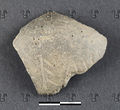WE-2: Difference between revisions
No edit summary |
No edit summary |
||
| (4 intermediate revisions by the same user not shown) | |||
| Line 15: | Line 15: | ||
|condition=damaged, fragmentary | |condition=damaged, fragmentary | ||
|sigla_mancini=BZ-31 | |sigla_mancini=BZ-31 | ||
|sigla_mlr=294 | |||
|sigla_tm=218572 | |||
|source=Schumacher 2004: 189, 214 | |source=Schumacher 2004: 189, 214 | ||
|checklevel=2 | |checklevel=2 | ||
| Line 22: | Line 24: | ||
First published in {{bib|Schumacher 1992}}: 189. | First published in {{bib|Schumacher 1992}}: 189. | ||
Pictures in {{bib|Schumacher 2004}}: Taf. 5,2 (drawing) and 6,1 (photo), {{bib|LIR}} (drawing). | Pictures in {{bib|Schumacher 2004}}: Taf. 5,2 (drawing) and 6,1 (photo), {{bib|LIR}} (drawing), {{bib|MLR}} (drawing). | ||
Length of the visible remains, including the upper tips of characters on the right, 2.6 cm. The scratches are well visible. {{c||E|d}} is clear; on the breaking edge to its left, the very tip of a bar may be visible (see drawing), but it might be merely an unintentional dent. It is therefore unclear whether there were characters before {{c||E|d}}. {{c||E|d}} is followed by a tip-up chevron, the lower part og which is broken off ({{c||U|d}} or {{c||A | Length of the visible remains, including the upper tips of characters on the right, 2.6 cm. The scratches are well visible. {{c||E|d}} is clear; on the breaking edge to its left, the very tip of a bar may be visible (see drawing), but it might be merely an unintentional dent. It is therefore unclear whether there were characters before {{c||E|d}}. {{c||E|d}} is followed by a tip-up chevron, the lower part og which is broken off ({{c||U|d}} or {{c||A}}). Then, in the upper area above the breaking edge, the tip of a scratch inclined to the left, a small angle opening to the right, and the very tip of another scratch. {{bib|Schumacher 2004|Schumacher}}'s tentative reading {{w||eais}} is unlikely, for the very reasons mentioned by himself: The scratch after the chevron is inclined, and would have had to merge with the hypothetical {{c||S|d}}, for which the angle is too small. The visible tips are too crowded to suggest actual letters; despite {{c||E|d}}, we are probably concerned with non-script. (See [[index::Non-script notational systems|here]] for a discussion of possible interpretations of inscriptions with doubtful status.) Note in this context that the inscription was applied before firing. | ||
{{bibliography}} | {{bibliography}} | ||
Latest revision as of 22:16, 8 November 2021
| Inscription | |
|---|---|
| Transliteration: | ]e[??? |
| Original script: | ] |
|
| |
| Object: | WE-2 potsherd (pottery) |
| Position: | outside |
| Script: | unknown |
| Direction of writing: | dextroverse |
| Letter height: | 1.8 cm |
| Number of letters: | 2 |
| Number of lines: | 1 |
| Craftsmanship: | incised before firing |
| Current condition: | damaged, fragmentary |
| Date of inscription: | |
| Date derived from: | |
|
| |
| Language: | unknown |
| Meaning: | unknown |
|
| |
| Alternative sigla: | LIR BZ-31 MLR 294 TM 218572 |
| Sources: | Schumacher 2004: 189, 214 |
Images
|
Object WE-2 potsherd with inscription WE-2.
|
Commentary
First published in Schumacher 1992: 189.
Pictures in Schumacher 2004: Taf. 5,2 (drawing) and 6,1 (photo), LIR (drawing), MLR (drawing).
Length of the visible remains, including the upper tips of characters on the right, 2.6 cm. The scratches are well visible. ![]() is clear; on the breaking edge to its left, the very tip of a bar may be visible (see drawing), but it might be merely an unintentional dent. It is therefore unclear whether there were characters before
is clear; on the breaking edge to its left, the very tip of a bar may be visible (see drawing), but it might be merely an unintentional dent. It is therefore unclear whether there were characters before ![]() .
. ![]() is followed by a tip-up chevron, the lower part og which is broken off (
is followed by a tip-up chevron, the lower part og which is broken off (![]() or
or ![]() ). Then, in the upper area above the breaking edge, the tip of a scratch inclined to the left, a small angle opening to the right, and the very tip of another scratch. Schumacher's tentative reading eais is unlikely, for the very reasons mentioned by himself: The scratch after the chevron is inclined, and would have had to merge with the hypothetical
). Then, in the upper area above the breaking edge, the tip of a scratch inclined to the left, a small angle opening to the right, and the very tip of another scratch. Schumacher's tentative reading eais is unlikely, for the very reasons mentioned by himself: The scratch after the chevron is inclined, and would have had to merge with the hypothetical ![]() , for which the angle is too small. The visible tips are too crowded to suggest actual letters; despite
, for which the angle is too small. The visible tips are too crowded to suggest actual letters; despite ![]() , we are probably concerned with non-script. (See here for a discussion of possible interpretations of inscriptions with doubtful status.) Note in this context that the inscription was applied before firing.
, we are probably concerned with non-script. (See here for a discussion of possible interpretations of inscriptions with doubtful status.) Note in this context that the inscription was applied before firing.
Bibliography
| LIR | Alberto Mancini, Le Iscrizioni Retiche [= Quaderni del dipartimento di linguistica, Università degli studi di Firenze Studi 8–9], Padova: Unipress 2009–10. (2 volumes) |
|---|
